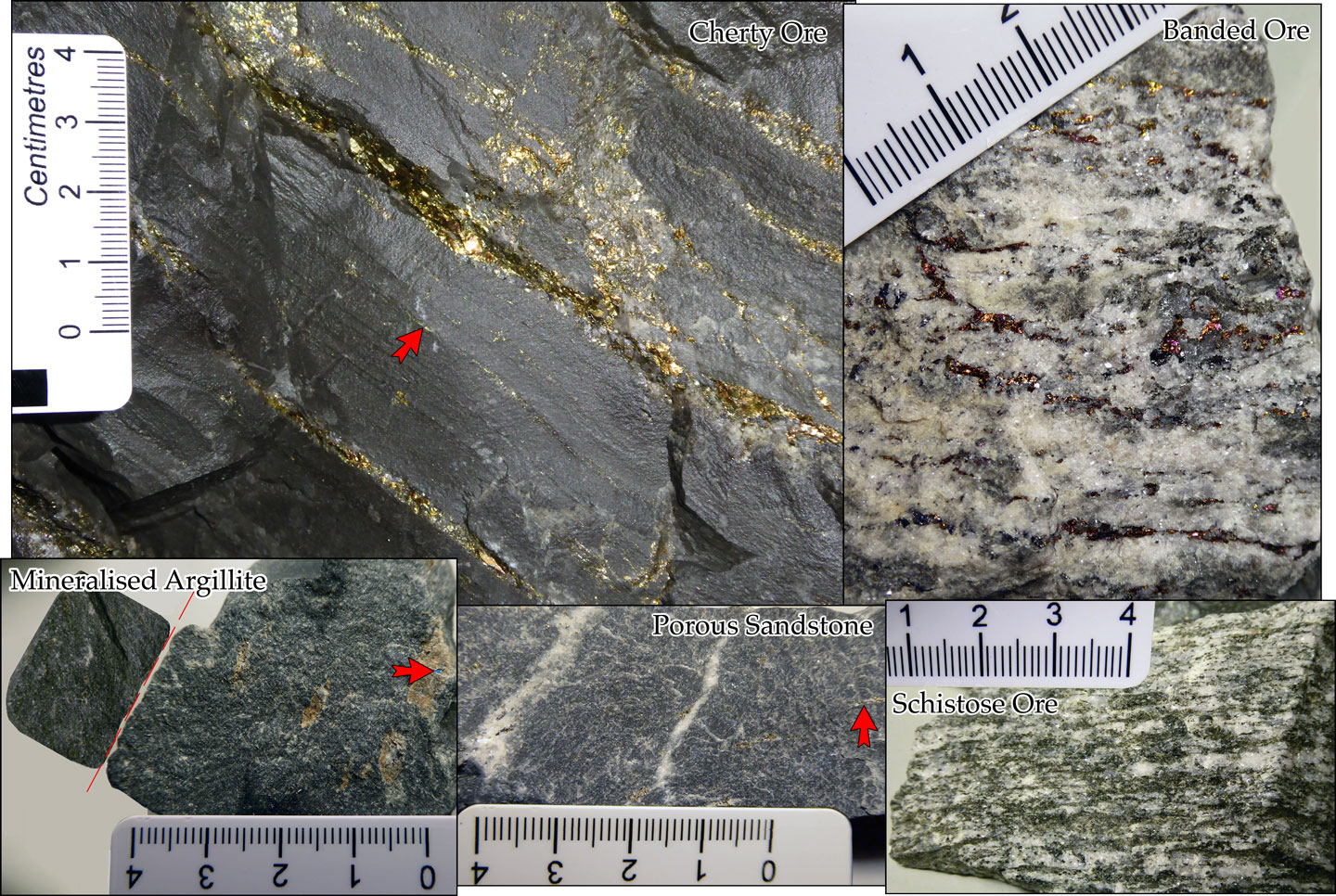| ||||||||
|
Lithologies and ore types of the Copperbelt Orebody Member at Mindola, Zambia - The bulk of the ore in the Nkana Central-Mindola mine area is hosted by the Copperbelt Orebody Member, which is immediately underlain by a 0 to 4 m thick, massive cobble to pebble Footwall Conglomerate at the top of the Footwall Quartzite unit, both of which are not significantly sheared. The base of the Copperbelt Orebody Member is marked by a relatively sharp planar contact with the ~2 m thick, variably mineralised, sheared Schistose 'Ore' (lower right image) composed of micas, dolomite and anhydrite. The speciment above is not well mineralised. This is in turn followed by 1.5 to 2 m of Low-grade Argillite, or siltstone, (similar in appearance and composition to the Mineralised Argillite near the top of the ore zone - bottom left). The next unit is the 2 to 4 m thick schistose Banded Ore (upper right), composed of alternating thin interbeds of white dolomite and sheared grey argillite with bands and branching veins of chalcopyrite and bornite. The Banded Ore is followed by 1 to 4 m of Cherty Ore (upper left), a hard, silicified, massive to bedded, non-schistose grey argillite with sparse white dolomite laminae, conformable, bedding controlled disseminations (arrow head), veinlets and veins of copper sulphides, as well as crosscutting sulphide and quartz-sulphide veins and veinlets. This is capped by the 0.5 m thick No. 1 Marker, similar in appearance to the Schistose Ore and Banded Ore layers. The Porous Sandstone (lower-middle), which is 0 to 4 m thick, and varies from a massive, khaki, siliceous, dolostone, through a dolomite-anhydrite rock, to a massive algal dolostone with stromatolites, with disseminations and thin veinlets (arrow head) of bornite and chalcopyrite. While not a sandstone where fresh, its name derives from its surface, weathered expression, where the carbonate components have been removed, leaving a residual, friable, porous sandstone. This carbonate rich unit grades upward through a 0 to 3 m thick transition to the 0 to 2 m thick Mineralised Argillite (lower left), a massive dolomitic siltstone with local dolomite streaks and nodules (beige lenses in image) with associated bornite (e.g., arrow head). The surface on the main part of this image is parallel to fissility, while that section to the left of the red line is perpendicular to fissility. The Mineralised Argillite then grades upwards into the 5 to 10 m thick Hangingwall Argillite, which is seldom mineralised and marks the top of the Copperbelt Orebody Member. It comprises a grey dolomitic argillite or siltstone, locally rich in dolomite spots and anhydrite blebs, which coarsen upwards towards the overlying Hangingwall Quartzite. The Cherty Ore was photograped in situ during a visit in 2014, while the other specimens were collected by Mike Porter during earlier visits in 1992 and 2001. Photographs by Mike Porter. 
| ||||||||




